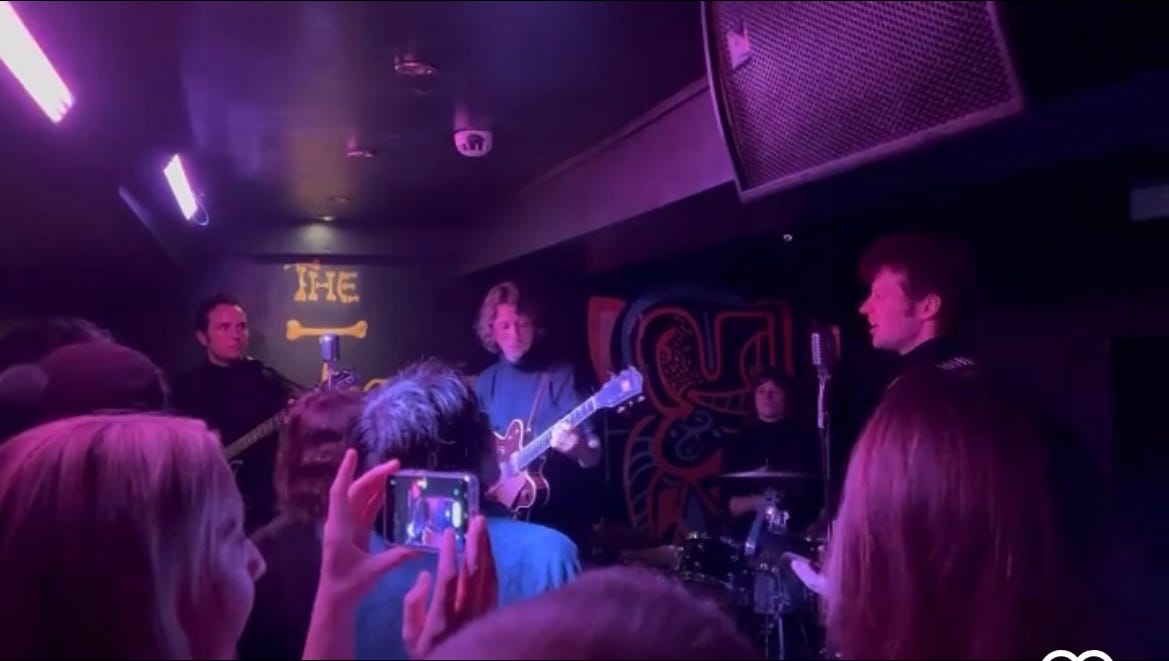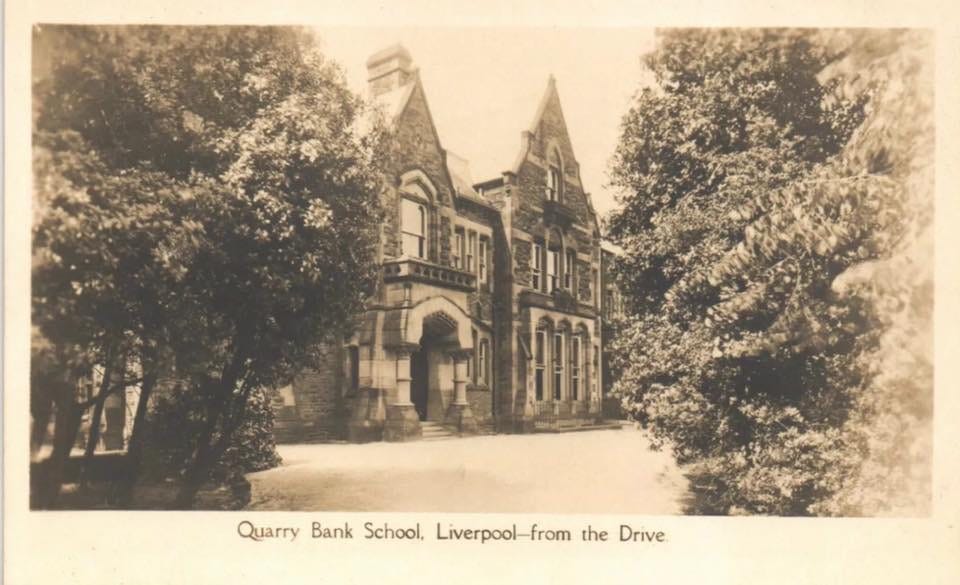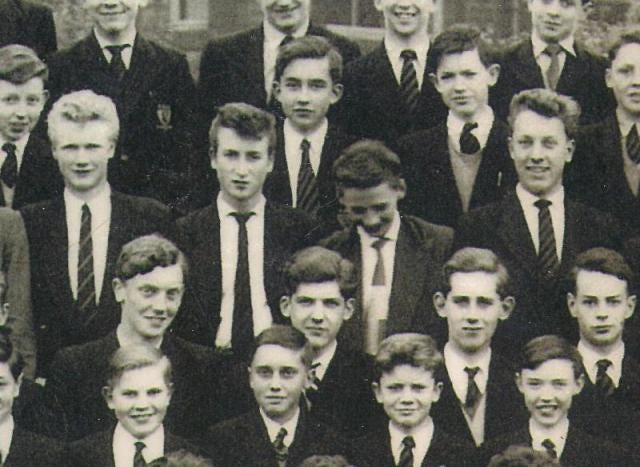John’s Old School Tie
In this issue John moves on to a less than successful secondary education that in some ways laid the foundation for what was to follow.
In this month’s newsletter we take a look at John’s tumultuous school days between the ages of 12 and 16 at Quarry Bank High School in Liverpool.
But first some…
Beatley News Updates
The Savage Young Beatles @ International Beatles Week
Liverpool’s own International Beatles Week event was held recently. Rounding off the festivities, The Savage Young Beatles played two 45 minute sets in the afternoon on Monday, August 28th at the free Penny Lane Festival on the iconic Penny Lane itself, surrounded by features referred to in the song; then in the evening they headlined a packed gig at the historic Jacaranda club.
2024 Festivals
Discussions are already underway related to some Beatles festival related appearances in 2024. Stay tuned for more on that as things get finalized.
Rock out to the new BTWB Playlist
If you enjoy the early rock-n-roll years and the music that inspired the Fab Four you can now enjoy a great selection of songs from the period on the new Before They Were Beatles playlist on Spotify -
Podcast Updates
The Before They Were Beatles podcast - Episode 25 is now live and available on your podcast platform of choice.
Entitled “Beginnings and Endings” it covers the events of September through to December 1962 as we complete our journey as The Beatles return to the recording studio, make their TV debut, and say goodbye to Hamburg.
BUT it isn't the end of the podcast. I'm taking a few months break, and will be returning with a new show - The Forgotten Beatles. - More on that to come.
Again a big shout out of appreciation to anyone who's given the shows a listen over the last couple of years.
For more information on what else I have going on with writing, podcasting, and general slice of life stuff, check out my regular FREE weekly CAN’T SEE THE FOREST newsletter -
And now on to the good stuff…
This month I’m making the full contents of this newsletter available to all subscribers, but if you’d like to keep this level of access, then please consider upgrading to a Paid Subscriber for future editions as we continue our story.
1956 - Quarry Bank School
At the age of eleven John Winston Lennon passed the required state examinations (1) to be accepted to continue his education at the local Quarry Bank High School.
It was something of a foregone conclusion that John would do well as his natural intelligence had enabled him to shine at Dovedale Primary School. His guardian, Aunt Mimi, had already decided where she wanted John to go. His results were good enough for him to attend the prestigious Liverpool Institute, but Mimi’s brother-in-law Alf Smith was a teacher there and in a remarkable piece of foresight she didn’t want John potentially creating problems at school that might cause family friction. She had her mind set on somewhere closer to home, a literal walk across Calderstones Park, and that was Quarry Bank.
Quarry Bank was founded in 1921 as Quarry Bank High School for Boys and its first intake of 225 pupils was on 11 January 1922. The school (2) is located opposite Calderstones Park on Harthill Road in the Liverpool suburb of Allerton. The house at the center of Quarry Bank High School (3) was completed in 1867 for John Bland, a prosperous timber merchant. It was notable for the woodwork and mirrors of the entrance hall, which are still in-situ today. The house was purchased by Liverpool Corporation in 1920 with the intention to convert it into a school.
The school’s first headmaster, R. F. Bailey introduced many ideas that he had encountered at the public schools he’d attended in his youth into the new school in south Liverpool. As well as giving the school a Laitin motto, Ex Hoc Metallo Virtutem (From This Rough Metal We Forge Virtue), and a school song:
Quarry men old before our birth
Straining each muscle and sinew
Toiling together, Mother Earth
Conquered the Rock that was in you.
He also introduced a House System which survived until 1967. He started a Unity Boy's Club and devoted his life to the boys of Quarry Bank and the development of the school.
During World War 2 there was slight bombing damage to the school site and for a time during 1940 the school and its pupils were evacuated to Wrexham in North Wales for safety (4).
In fact prior to the war the school had been a fee paying establishment, but following the 1944 Education Act it had become a free state run grammar school, open to all, if they could pass the entrance examination. Despite its new status it was still run very much on the lines of a traditional public school, including a school uniform. The boys were instructed to wear black blazers with a thin band around the sleeve cuff with the school’s mascot of a stag’s head picked out in gold. The obligatory school cap had thin piping of different colors to denote which House you belonged to. While the school tie was a basic black with gold stripes. All of which could be purchased from the school’s official outfitters, Wareings & Co, on Smithdown Road.
The influential R. F. Bailey retired in 1947 after 26 years at Quarry Bank, and was succeeded by Mr E. R. Taylor who stayed until 1956 when he moved to Wolverhampton Grammar School. It was during E. R. Taylor's time that a certain John Winston Lennon was admitted to the school on 4th September 1952.
On arrival at Quarry Bank, John realized that he was going to encounter a much stricter and controlling world than he had during his primary school days. There were going to be a lot more rules. Initially he continued his aggressive ways in an effort to establish himself as a leader. Later in a desperate attempt to become popular he and Pete Shotton, who perhaps unfortunately had both been assigned to the same house, Woolton House, soon established themselves as ‘the class clowns,’ always up for a joke or a lark. As they worked their way up the school over the next four years their grades fell.
When he arrived John was considered a bright pupil and did well in his first year and was placed in the A stream for potentially outstanding students for his second year, but he failed to concentrate in lessons, and rarely completed homework assignments and slipped to twenty-third out of the twenty three students in his class. His main focus at Quarry Bank was instead swearing, smoking, and skipping lessons. As a result, by his third year he had dropped to the B stream and ranked thirtieth out of thirty-four, just enough to stay in the B stream for another year. But his final year was worse, as he was once again demoted, this time to the C stream, and was ranked twentieth out of the twenty pupils in the class. Academically it was impossible for him to fall any lower.
As Ray Coleman quotes a fellow pupil in his excellent biography of John, “From day one he roared through the school. He set out to be a noise, aided and abetted by Pete Shotton. John was the leader in any partnership, and Shotton became his lieutenant in the hundreds of misdeeds that became legendary in the school history.”
On the surface John’s rebellious streak seems to be somewhat unforgivable, but on reflection there may have been underlying problems associated with his disrupted family situation, and undiagnosed eyesight issues. It was only when John’s academic record started to plummet in the later stages of his time at Quarry Bank that one school report prompted his guardian, Aunt Mimi, to go get his eyes tested. There was no debate, young John Lennon was in desperate need of glasses. But he hated wearing them. The fact that he hadn’t been able to see the classroom blackboard properly throughout certainly didn’t help his grades, and almost contributed to a sense of isolation. In retrospect it may be possible that John Lennon was simply bored at school.
At home things were different for while John would throw his school reports out the window in the hope that his Aunt wouldn’t get to see them, he was an avid consumer of the written word, and producer of cartoons. As Mimi recalled ‘he was always looking for something to do or read, a very active child. And he loved to talk about growing up.’
Once a boy like John became notorious at school he tended to get picked on by teachers who didn’t know how to deal with him. He was constantly in trouble.
“Every situation I remember John in, he led. The guys who were frightened of him, which was quite a lot, kept out of his way. He had a sharp tongue and didn’t mind a fight,” his fellow pupil recalled, ‘but those who adored him just followed. John’s attitude to school was “to hell with the lot of them.” ’
Whether the headmaster, Mr. Taylor’s move to Wolverhampton was prompted by the young Lennon’s antics isn’t known, but it’s clear he didn’t have much regard for his former pupil describing him as ‘an under-achiever who made no real positive contribution to the life of the school. He did not share in what we set out to do… I think he despised what we were trying to do in our traditional manner.”
In 1956 thirty-five year-old Mr William E Pobjoy, a languages specialist, became Headmaster. ‘I inherited an extremely disruptive boy, the legend of the school. He was presented to me as my most urgent problem, him and his friend Shotton.’
In his book on the Quarrymen, writer Hunter Davis states that Pete and John always maintained that the staff and the school failed them rather than they failed the school. That they were being force fed by out of touch masters and a dated system. It’s probably a valid viewpoint.
Despite his reputation and overt disregard for the conventions of the education systems, several of his teachers noted that there was something about John Lennon; he was witty, had a wicked sense of humor, the standard of his work in English, literature, and poetry were well above average, and that when he got to do something his own way the results were often excellent, if different. Perhaps the best illustration of this was his underground school magazine, The Daily Howl, in which he drew outlandish caricatures of the various teachers accompanied by word play gags. It became a habit for the teachers to confiscate these and then pass them around the staff room to enjoy for themselves. It wasn’t art in the conventional manner, but it was certainly unique.
William Pobjoy decided that the best approach was that rather than to meet John head on through punishment (5), he would try to get to know John Lennon as an individual. After discussions with both John and Mimi, he, along with John’s English teacher, Philip Burnett, began to see something in John that no-one else had, and they would set him on a path that would allow him to fulfill his destiny.
Realizing that John’s talents lay outside the mainstream classifications of the British education system, William Pobjoy arranged for John to interview with the principal of the Liverpool Art College, and for once John behaved himself for long enough, with Pobjoy’s recommendation, to be accepted into art school.
Many years later, replying to a fan letter from a pupil at Quarry Bank, John wrote:
“Remember me to anyone who is still there, even to Pobjoy. After all it was he who got me into art school, so I could fail there too, and I can never thank him enough.”
Author’s Notes
Colloquially referred to as the “eleven-plus” exam. It was a standardized examination taken by students in England and Northern Ireland in their last year of primary education. It was a purely academic test, the results were used to determine admission to grammar schools and other secondary schools. The name derived from the age at which most pupils started their secondary education, 11–12 years-old.
After a series of mergers with other schools it is now a co-ed establishment known as Calderstones School.
Excavations during building projects as the school expanded over the years have shown that other dwellings had stood on what is now the school grounds.
Coincidentally that is where my own father was also evacuated to as a child around the same time.
Shortly after arriving at Quarry Bank school WIlliam Pobjoy abolished corporal punishment, becoming the first school in Liverpool to do so, a full thirty years ahead of it being banned by law in the UK.
Recommended Reads
History of Calderstones School (1924-199) https://www.calderstones.co.uk/History-of-Calderstones-School/
Coleman, Ray - Lennon: The Definitive Biography - HarperPerrenial - 1992 - ISBN 0-06-098608-5
Davis, Hunter - The Quarrymen - Omnibus Press - 2001 - ISBN 0-7119-8526-X
Lewisohn, Mark - The Beatles: Tune In - Little Brown - 2013 - ISBN 978-0316-72960-4
Join us next month as we get to know John’s best friend, and fellow Quarry Bank pupil, Peter Shotton.
And if you enjoyed this month’s newsletter please feel free to share.
See you next time.
Alan J. Porter










Excellent! Impeccably researched, wow. Great read. Love it. Keep the fantastic work going!